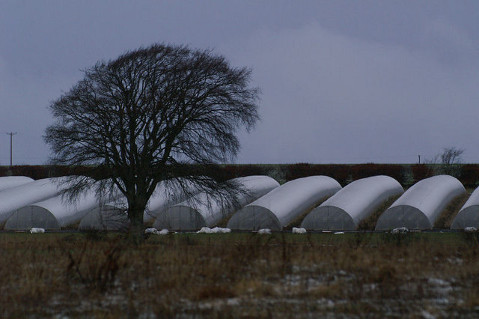County Supervisors to Amend Hoop House Permit Exemption Code
Structure Height May Rise from 12 to 20 Feet

A battle over hoop houses that previously pitted supervisors Peter Adam against Salud Carbajal brought the two political antagonists together this week at the county Board of Supervisors. In a 3-2 vote, the supervisors took steps to extend the height exemption on the books for hoop houses — large tent-like structures covering North County farmland — to a maximum of 20 feet from the current height of 12 feet.
The issue of permitting hoop houses emerged last year when County Planning staff discovered an estimated 4,500 acres of farmland is covered in unpermitted hoop houses. (It came up after Windset Farms sought an exemption to the permit required by the county’s building code.)
Adam — who owns Adam Brothers Family Farms with his two younger brothers — brought the item to the board last year. He argued hoop houses were essential tools for farmers to conserve water and minimize pesticide use and that they should not require a building permit. He first proposed hoop houses of any height to be exempt. The South County supervisors squawked; Carbajal likened such a move “carte blanche.” No decision was made.
Meanwhile, the Ag Advisory Committee informed staff that virtually all hoop houses in the county are less than 20 feet tall. The item — and tension — returned to the board this week. Supervisor Steve Lavagino lamented: “I don’t why this is so so so difficult.” Lavagnino acknowledged some people have complained about the aesthetics of the hoop houses. “I can understand, but to me hoop house looks better than cookie cutter development.” If agriculture is not viable for farmers, he argued, there could be pressure to develop the land. “We’ve got to get creative,” he said. Lavagnino, Carbajal, and Adam voted to amend the building code to raise the exemption height to 20 feet.
Supervisors Doreen Farr and Janet Wolf, however, objected. The second part of this issue is that the zoning code is silent on hoop houses (except in Carpinteria where they are addressed in the Carpinteria Agricultural Overlay District). Updating the zoning code is a more complex process, involving CEQA and a long-range work plan. In order to address the issue, both the building and zoning code need to be updated. Wolf argued a quick fix was an “unfortunate way to go about it.” Farr added: “This is not the way to make a policy decision.”
The zoning code piece will return to the board during the April budget workshops.



